Abstract
The paper discusses topical issues and problems of water supply in scarce and arid regions of the country, including the redistribution of water flows from high-flowing Siberian rivers, which are heavily overflowing during the flood period. In particular, an overview of world experience in solving water supply problems is given, both through desalination of sea water and the use of underground sources, and through the construction of canals and main water pipelines, from futuristic ideas to projects that have already been implemented and have many years of positive operating experience. Special attention is paid to the domestic union experience, plans to turn large rivers to supply the Central Asian republics, the world’s first nuclear plants for desalination of sea water and a main water conduit to supply the Mangyshlak Peninsula. Based on the results of the analysis performed, the main disadvantages, areas, limitations and advantages of various water supply options are identified, which make it possible to draw a conclusion about the possibility of involving unclaimed capacities of main oil and gas pipelines to solve the problems of compensating for the shortage of water resources at the expense of the country's deep Siberian rivers.
1. Introduction
According to UNESCO forecasts, in about 10 years the world will face a shortage of water resources [1]. By 2030, the shortage could be 40 %. Despite the fact that Russia occupies a leading position in Europe in terms of total fresh water resources, there are also regions in the country where water shortages are already brewing. According to numerous forecasts, in the future, fresh water will become one of the main resources on the planet, not only for consumption, but also as an important energy carrier and energy resource, which is actively promoted by the development of hydrogen energy and the important role of green hydrogen electrolysis.
Thus, the largest reserves of surface fresh water resources are in the East Siberian regions – primarily the Krasnoyarsk Territory and the Republic of Sakha (Yakutia), the smallest, which is associated primarily with a large volume of consumption, and secondly with a variable seasonal deficit, – the Republic of Crimea, Kalmykia, Ingushetia, Belgorod, Kurgan and Kursk regions. About 15 constituent entities of the Russian Federation have water resources of less than 10 km3/year [2].
One of the main deficit factors is the uneven distribution of water flow across the country: 84 % of surface water resources are in the basins of the Arctic (3030 km3/year) and Pacific Oceans (950 km3/year). The largest Siberian rivers flow into them: the Yenisei, Lena, Ob and Amur, which provide 44 % of the flow of all rivers. The Southern and South-Western regions (basins of the Black and Azov Seas, the Aral-Caspian lowland), where about 75 % of the population and 80 % of industry and agricultural production are concentrated, account for only 16 % of surface water resources. On the European territory of the country, the flow of rivers of the southern slope (Volga, Ural, Dnieper, Don, Kuban, Kura, Terek, etc.) is 50 % of the river flow in this part of Russia, which experiences seasonal fluctuations and depends on the level of water consumption of border countries.
On the other hand, the seasonal irregularity of water flow distribution (over 60 % of the flow passes during 2-3 months of spring floods) often leads to natural disasters – huge excesses of unclaimed water resources annually wash away the already poorly urbanized areas of the settlements of the region.
In recent years, water problems have significantly escalated due to anthropogenic changes in river flow and mismanagement. In the most inhabited regions of the country, there are no large rivers left undisturbed by anthropogenic activities, both on the watersheds and in the channels of the rivers themselves. The following have had a significant impact on the flow and quality of water: agrotechnical forest reclamation measures, urbanization, irrigation and drainage reclamation, an increase in the number of reservoirs and demand for green hydropower, significant water withdrawals for irrigation, industrial household needs, and discharge of polluted wastewater.
In a number of industrialized regions of the country (Moscow, St. Petersburg, etc.), intensive exploitation of groundwater causes a constant decrease in their level (up to 1 m per year). Depression cones in areas of concentrated groundwater withdrawal have already developed over an area of hundreds of square kilometers. In these areas, the quality of groundwater is deteriorating, there is a suction of sea water to water intakes, for example, in the Crimea, subsidence of the earth's surface, and karst processes are activated. The level of pollution of water bodies in large cities is rapidly deteriorating from year to year. The most acute problem of supplying safe drinking fresh water is already appearing simultaneously in several regions – Vladimir, Arkhangelsk, Astrakhan regions, Altai Territory, Adygea, Karachay-Cherkessia. In the latter, according to Rospotrebnadzor, only half of the population can use safe drinking water. A difficult situation is also noted in the Kurgan region - where only 68.3 % of the population has access to quality water, the Republic of Buryatia – 67.9 %, the Kostroma region – 66.7 % of the population. The lowest indicator of accessibility to clean drinking water is in the Vologda Oblast – only 42.9 %. An acute problem with water, both for agriculture and drinking needs, caused by geopolitical reasons, is observed in the Crimea [3].
According to some expert estimates, the water resources of the rivers of the European zone – the Don, Kuban, Samur, Volga, Ural – are almost completely exhausted, and for a number of other rivers in Russia, the Northern Dvina, Neva, Sulak, Terek, Amur, etc., – have been developed by three quarters or more. The conclusions are obtained for the conditions of the current level of water use and a stable trend towards shallowing of the main rivers. Thus, in the endowment of a large amount of natural resource of surface and underground fresh water in Russia, the main problem of their irrational use is the uneven distribution of surface sources of fresh water and levels of anthropogenic load, mainly concentrated in highly urbanized areas of the western part of the country (see balance maps in Fig. 1).
The above circumstances and the problems of growing global water consumption associated with population growth and plans for the development of hydrogen energy, already in the medium term, raise the country's questions of fresh water shortage.
Unlike the countries of the Middle East and Africa, or even China, where water supply problems are associated with a natural lack of fresh water and a dry climate, as well as with a rapidly growing population and the development of agricultural industries with forced irrigation systems, Russia, with its long undeveloped territories, has the richest reserves of water resources and a diverse climate abundant in precipitation with a natural increase in water flow, while it is important that, unlike the above-mentioned countries, population growth in Russia is not only not a problem, but, on the contrary, is an important strategic task for development of Siberia, the Arctic and the Far East [6].
Fig. 1Uneven distribution of reserves and the level of water consumption from surface fresh sources in the Russian Federation
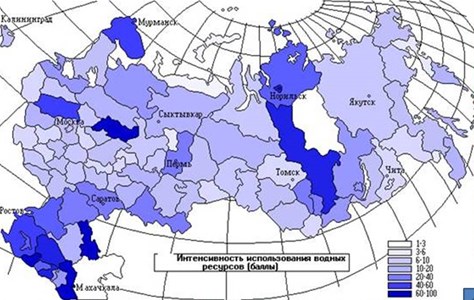
a) Potential fresh water resources
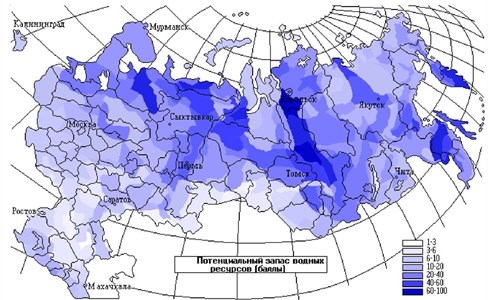
b) Fresh water use intensity
2. Foreign experience analysis
The lack of fresh water and the absence of surface sources in the countries of the Middle East first led to the active development of underground sources, but due to their shortage or complete absence in most countries of the Persian Gulf, seawater desalination plants are being built everywhere, characterized not only by the high cost of its production, but the formation of colossal volumes of highly concentrated brine, the complexity and high cost of processing of which [7], leads to an increase in water salinity in places of its discharge into the sea.
Fig. 2The world’s largest seawater desalination plant in the city of Jubail (Kingdom of Saudi Arabia) Saline Water Conversion Corporation
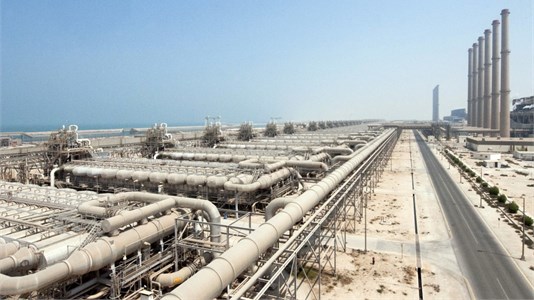
According to open sources in the Kingdom of Saudi Arabia, which hosts the country’s largest water desalination plant in the world (Fig. 2), up to 10 % of hydrocarbon resources are spent on own needs for desalination and water distribution. Warnings about the danger of brine discharge into the water area are also being discussed in our country today in the context of the problem of Crimean water supply due to seawater desalination with subsequent brine discharge into the Sivash Bay [8].
To deliver desalinated water in the Kingdom of Saudi Arabia, which has a relatively large territory by the standards of the Middle East region, a whole network of main water pipelines with a diameter of up to 2 m with an average flow rate of over 15,000 m3/hour has been introduced, representing an extended system (Fig. 3) with all the necessary controls and protection that is not inferior to gas and oil pipelines.
Fig. 3The system of water trunk pipelines of the Kingdom of Saudi Arabia for the supply of desalinated sea water (Saline Water Conversion Corporation)
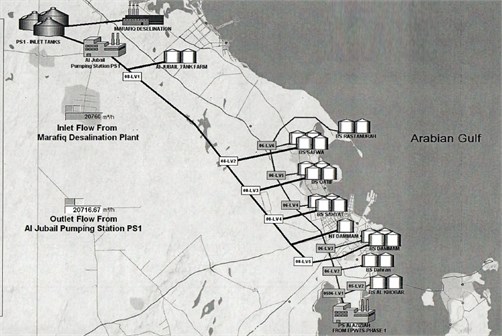
The world’s largest irrigation system project to deliver fresh water from an alternative source was implemented in Libya under the Gaddafi government, called the Great Man-Made River [9]. So, the unsuccessful search for oil reserves in the southern part of the country unexpectedly led to the discovery of gigantic underground reserves of drinking water – about 35,000 cubic kilometers. This volume of water could completely cover the territory of a country like Germany, while the depth of a similar reservoir would be up to 100 meters. And according to recent studies, the water from the Libyan artesian springs will last almost 5,000 years. Prior to the commissioning of the aqueduct network (Fig. 4-5), the cost of importing demineralized sea water was 3.75 dollars per ton. The construction of its own water supply system allowed Libya to completely abandon imports. At the same time, the sum of all costs for the extraction and transportation of 1 cubic meter of water cost the Libyan state (before the war) 35 US cents, which is 11 times less than before. This was already comparable to the cost of cold tap water in Russian cities. For comparison: the cost of water in European countries is up to 2 euros. The value of the Libyan water reserves is estimated at about 5-7 times higher than the value of the reserves of all its oil fields. Even assuming minimum prices of 30-35 cents per cubic meter of water, achieved in the Kingdom of Saudi Arabia through the use of energy-efficient desalination methods, the cost of Libyan water reserves can be 10-15 trillion dollars (with a total cost in the Nubian aquifer of 55 trillion [10]).
In Egypt, where the problem of water supply is not so acute, but a large area requires the distribution and delivery of water resources of the full-flowing Nile, from the Nasser reservoir and Lake Toshka, formed as a result of its excessive floods, to remote southwestern regions of the country for irrigation of desert lands, is being implemented the New Valley project [11]. The agricultural purpose, the presence of a fresh water source and the natural slope of the relief determined the choice of an extended network of water channels instead of the main system of water conduits.
Fig. 4Pipelines of the irrigation system “Man-made River of Libya”
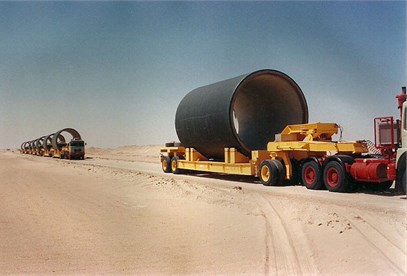
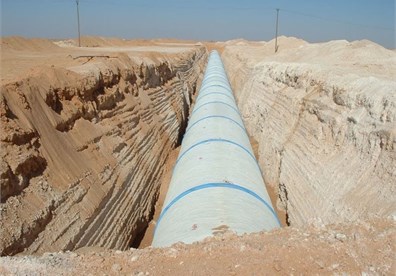
Fig. 5The largest irrigation system “Man-made River of Libya”
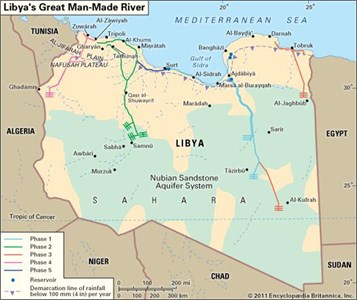
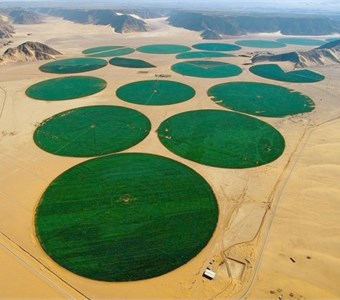
Another grandiose global project is the turn of the Chinese rivers - the transfer of the Yangtze River to the north, to the basins of the Yellow and Hai rivers, which started in 2022 (Fig. 6). The choice of scheme (Fig. 7) is associated with a drier climate in the North of China than in the southeast, and the Yangtze is much more full-flowing than the Yellow River and Hai, and often causes severe floods in the lowlands of the country [12].
Fig. 6Starting point of the central water channel in Sichuan
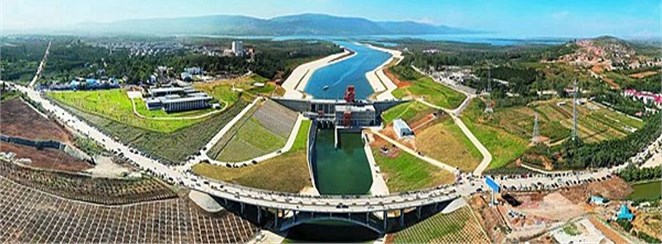
The most ambitious and at the same time futuristic engineering project in history is the Atlantropa, proposed in the 1920s by the German architect Hermann Sergel (Fig. 8). The project, which remained theoretical, provided for the drainage of part of the Mediterranean Sea through the construction of dams and hydroelectric power plants on the Strait of Gibraltar and the Dardanelles. In a similar way, it was supposed to receive cheap electricity in abundance, including for desalination and supply of sea water to the countries of North Africa [13].
Fig. 7Scheme of water channels of the China Diversion Project
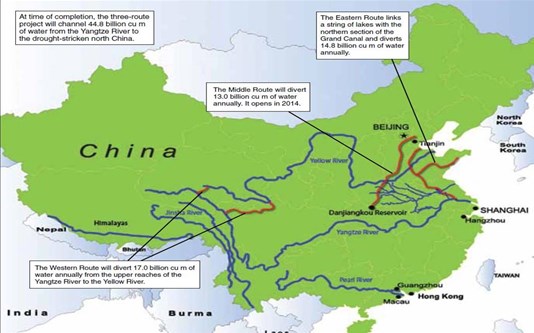
Fig. 8Futuristic engineering project “Atlantropa”
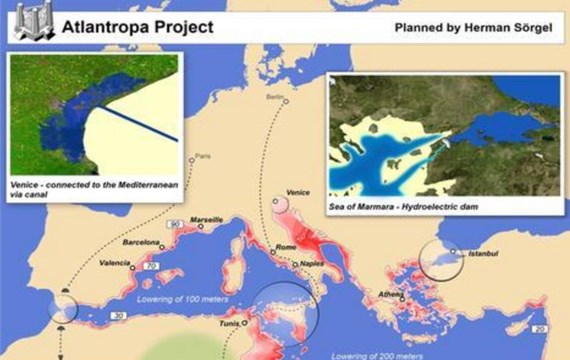
3. Domestic experience
The transfer of part of the flow of Siberian rivers to Kazakhstan and Central Asia (turning full-flowing Siberian rivers) – an unrealized Soviet project aimed at providing water to the arid regions of the USSR, is rightfully one of the most grandiose unrealized engineering and construction projects of the 20th century. The transfer of the water flow of the northern rivers was originally planned on the territory of the European part of Russia to the Volga in order to stop the rapid decline in the level of the Caspian Lake, in addition, it was supposed to implement large-scale irrigation projects - the Volga-Don 2 canal and the Volga-Chogray canal [14]. The Volga-Chogray project was close to implementation, but was suspended due to the risks of provoking soil erosion and soil salinization, the emergence of new foci of tularemia in Kalmykia, disruption of saiga migration routes, death of sturgeon juveniles at the water intake site, which resulted in a hail of public criticism.
In the 1950s, in the Kazakh SSR, this issue acquired practical significance – several schemes for diverting rivers were developed at various institutions, after which all-Union meetings were held on this issue in Tashkent, Alma-Ata, Moscow, Novosibirsk, which was influenced by a sharp increase in 1960s water consumption for irrigation primarily in Kazakhstan and Uzbekistan.
Fig. 9The proposed scheme for the turn of the Siberian rivers
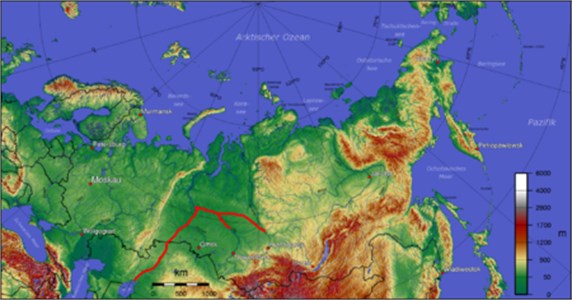
In 1968, the Irtysh-Karaganda irrigation and watering canal was put into operation, which is in fact the first part of the project to provide water to central Kazakhstan. The main goal of the project was to direct part of the flow of Siberian rivers (Irtysh, Ob, Tobol, Ishim and others) to the regions of the country that are in dire need of fresh water. The project was developed by the Ministry of Land Reclamation and Water Resources of the USSR (Ministry of Water Administration). At the same time, a grandiose construction of a system of canals and reservoirs was being prepared, which would make it possible to transfer water from the rivers of the northern part of the West Siberian Plain to the Aral Sea. To assess the technical and economic parameters of the project “Territorial redistribution of a part of the free flow of the Ob and Irtysh rivers”, the USSR State Planning Committee established the State Expert Commission of the USSR Academy of Sciences, the State Committee for Science and Technology under the Council of Ministers of the USSR and the USSR State Committee for Construction, which preliminary approved the project, but already in 1986 at a special meeting of the Politburo of the Central Committee of the CPSU, it was decided to stop work. The decision to abandon the implementation of the project according to the official version was influenced by numerous publications on environmental risks, which formed a negative opinion in society and academic circles.
One of the most ambitious decisions close to being realized and approved by Stalin was the construction of the Stalingrad Canal, thanks to which the deserted Western Kazakhstan was supposed to turn into a flowering land covered with fields, meadows and even forests. The basis of the miracle canal was to be the Stalingrad reservoir, due to the construction of the dam of the Stalingrad hydroelectric complex, from where it was supposed to restart a significant part of the Volga flow for watering the land in the Volga-Ural interfluve in Kazakhstan. A gravity canal would essentially be a branch of the Volga to the shores of the Urals, where the historical confluence of the two greatest streams feeding the Caspian was to take place [16].
Despite the fact that none of these projects was ever implemented, the water of the Volga still reached the most arid regions of Western Kazakhstan without sources of fresh water – the Mangyshlak Peninsula, where oil fields were discovered that had a strategic impact for the country. The main water pipeline “Astrakhan – Mangyshlak” has been in operation for more than 30 years, and the number of its consumers is growing every year. According to JSC “KazTransOil”, an oil pipeline company of Kazakhstan involved in the management and operation of the water pipeline, today water is provided to the population of the 70-thousandth city of Kulsary, 120000 residents of the city of Zhanaozen, 47000 people of the village of Beineu, as well as a number of other settlements, the population of which increases every year. In general, water from the main water conduit (Fig. 10) with a total length of 1285.9 km with an average annual throughput of 94 thousand m3/day (28.4 million m3 of water was supplied in 2020. [17]), are used by about 200 large consumers in Atyrau and Mangystau regions, including 23 oil and gas producing and 36 industrial enterprises, 20 utility organizations and more than 90 agricultural producers.
Fig. 10The main water pipeline “Astrakhan – Mangyshlak”
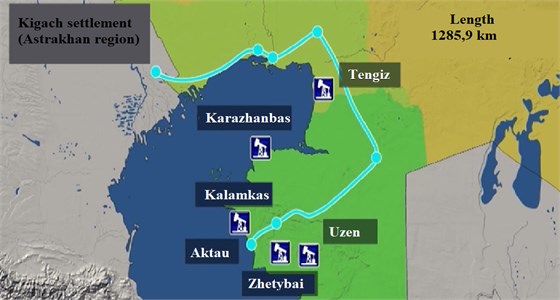
Domestic experience, also related to solving the problem of water supply to the arid regions of Mangyshlak, is not limited to the construction of a water conduit – in 1972, to supply fresh water and electricity to the city of Shevchenko (now Aktau), a BN-350 fast neutron reactor was launched with an installed thermal power of 350 MW, including at that time, the world's only nuclear desalination plant with a capacity of 120,000 m³ per day [18] (Fig. 11).
Fig. 11Desalination plants based on the nuclear reactor BN-350
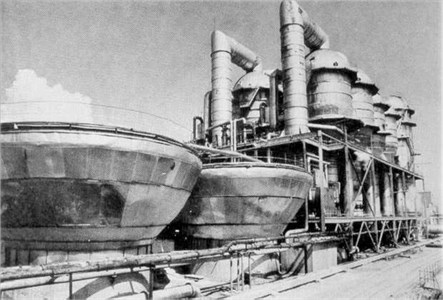
In 1999, in accordance with the concluded international agreements, the BN-350 reactor plant was transferred to the decommissioning mode, which will be carried out for more than 50 years. Currently, the production of electrical and thermal energy, steam, hot, technical and drinking water is carried out through three thermal power plants operating on dry gas.
4. Discussion
As the results of the presented review show, the issues of water supply and redistribution of water flows are raised in our country not for the first time, and moreover, the implemented domestic projects, affecting both the seemingly futuristic solutions for turning Siberian rivers and building canals today, as well as long-term operation of desalination plants and main water pipelines, speak of the rich experience and high significance of such projects for the country.
The results of a comparative multifactorial assessment of the considered options for solving water supply problems, taking into account environmental friendliness, energy efficiency and cost indicators of project implementation, are presented in Table 1.
Table 1Comparative assessment of various water supply options
Comparison parameter | Sea water desalination | Water channels for turning rivers | Water trunk pipelines |
Сapital expenditure (CAPEX) | High | Very high | Medium |
Operating expenses (OPEX) | Very high | Medium | Low |
Project implementation timeline | High | Very high | Medium |
Environmental risks | High | Very high | Low |
Capacity | Low | Very high | Medium |
Water quality | Medium | Low | Very high |
Fields of application | Need access to water areas | Limited by slope | Not limited |
Notes | Requires a network of water conduits | Subject to shallowing | Subject to corrosion |
As can be seen from Table 1, the most beneficial from the point of view of efficiency and environmental friendliness is the construction of water trunk pipelines from full-flowing rivers, which simultaneously solves the issues of regulating flood processes, and in addition, can be used in combination with desalination plants, transporting purified water from the most efficient saline water areas over long distances.
In the direction of choosing the main water conduits, the fact that the currently unclaimed capacities of the main oil and gas pipelines can also be involved in the implementation of this method. The expediency of their long-term use for solving important problems of water supply to deficient regions and redistribution of river flows is also dictated by the trend towards a decrease in the export of hydrocarbon raw materials due to the growing popularity of renewable energy, and primarily hydrogen energy, caused by the goals of achieving a carbon balance. Reprofiling sections of trunk pipelines for water transport will not only reduce the load on dwindling underground water sources and reservoirs, but also solve the problems of conservation and elimination of hydrocarbon pipeline transport routes that are no longer in demand, which still have a large residual resource and inventory value. Even if it is necessary to build new water conduits, the existing and extensive infrastructure throughout the country with a large number of stations will require investments only for the reconstruction of the linear part, while working on newly created facilities of the main pipeline water transport will not require the training of a new qualified staff, represented by already experienced specialists.
5. Conclusions
Undoubtedly, when implementing projects for the use of the existing system of trunk pipelines for transport and supply of fresh and desalinated water, it will be necessary to solve a number of engineering tasks, including work on preparing the linear part for a different properties product. In particular, it will be necessary to study the issues of transferring oil, gas and petroleum products pipelines for long-distance transport of prepared purified water, including the rehabilitation of existing and construction of new sections without the risk of loss of water quality. Nevertheless, it can already be concluded that the trunk pipeline transport of water is the safest and at least more environmentally friendly than other methods, and long pipelines along the whole country will allow solving a number of related problems of the regions and in the future can become one of the main sources for production complexes of green hydrogen by electrolysis.
References
-
“Valuing water,” The United Nations World Water Development Report, Paris, France, 2021.
-
“The state and use of water resources of the Russian Federation in 2018,” State Report, Moscow, Russia: NIA-Nature, 2019.
-
“The state of sanitary and epidemiological welfare of the population in the Russian Federation in 2018,” State Report, Moscow, Russia: Federal Service for Supervision of Consumer Rights Protection and Human Well-being, 2019.
-
A. V. Akimov, “The population of the Middle East countries until 2050 and the problems of water supply in the region,” (in Russian), Journal of Middle East and Modernity, Vol. 43, pp. 12–13, 2011.
-
B. N. Gashev and L. P. Zudina, “Water supply in the Arab countries of North Africa,” (in Russian), Journal of Middle East and modernity, Vol. 38, pp. 12–13, 2009.
-
E. L. Motroch, “Russian Far East: current demographic situation,” (in Russian), Journal of Regionalism, Vol. 4, pp. 1–8, 2019.
-
G. A. Sigora, “Overview of methods for processing brines formed as a result of the operation of distillation plants,” (in Russian), Journal of Successes of Modern Science, Vol. 1, No. 12, pp. 140–146, 2017.
-
V. I. Lyashevsky and A. M. Dzhaparova, “The problem of desalination of sea water in the Crimea,” (in Russian), Tauride Bulletin of Agrarian Science, Vol. 1, No. 3, pp. 63–68, 2015.
-
“GMR (Great Man-Made River) Water Supply Project,” https://www.water-technology.net/projects/gmr
-
L. Wedekind, “Great Lakes underfoot: a study of the oldest water treasures of North Africa,” Bulletin of the International Atomic Energy Agency, Vol. 45, p. 36, 2003.
-
“On Toshka New Valley’s mega-failure,” https://www.egyptindependent.com/toshka-new-valleys-mega-failure-slideshow/
-
“South-to-North Water Diversion Project,” https://www.water-technology.net/
-
“The Atlantropa Project: how to drain the Mediterranean Sea and why it is necessary,” https:// naked-science.ru/article/sci/proekt-atlantropa-kak-osushit
-
“Transfer of part of the Siberian rivers’ runoff to Central Asia,” http://arbuz.uz/w_aral_perebr.html
-
Ya. G. Demchenko, Flooding of the Aral-Caspian lowlands to improve the climate of adjacent countries. Kiev, Russian Empire: Printing house of S. P. Yakovlev, 1900.
-
“How the Volga almost flowed through Kazakhstan”, https://informburo.kz/stati/kak-volga-chut-ne-potekla-cherez-kazahstan.html
-
“The Eurasian Bank will help expand the Astrakhan-Mangyshlak water pipeline,” http://evrazia-ural.ru/novosti/evraziyskiy-bank-pomozhet-rasshirit-vodovod-astrahan-mangyshlak.
-
“MAEK-Kazatomprom LLP celebrates its 45th anniversary,” https://www.atomic-energy.ru/news/2013/07/10/42721
